Book contents
- Frontmatter
- PART I GOVERNMENT
- PART II ECONOMIC AND SOCIAL DEVELOPMENTS
- PART III SPIRITUAL, CULTURAL AND ARTISTIC LIFE
- PART IV THE DEVELOPMENT OF EUROPEAN STATES
- 17 Germany and the Empire
- 18 Hus, the Hussites and Bohemia
- 19 France
- 20 Burgundy
- 21 England
- 22 The Celtic world
- 23 Italy
- 24 The Iberian peninsula
- 25 The Swiss Confederation
- 26 The States of Scandinavia, c. 1390– c. 1536
- 27 Hungary: Crown and Estates
- 28 The Kingdom of Poland and the Grand Duchy of Lithuania, 1370–1506
- 29 Russia
- 30 Byzantium: The Roman Orthodox World, 1393–1492
- 31 The Latin East
- 32 The Ottoman World
- 33 Conclusion
- Appendix Genealogical Tables
- Primary Sources and Secondary Works Arranged by Chapter
- Index
- Frontispiece
- Plate section
- Map 1 European towns in the late Middle Ages
- Map 2 European commerce and trade
- Map 4 Winds and currents facilitating the discoveries
- Map 5 The universities o f Europe in 1400 and 1500
- Map 6 Germany and the Empire
- Map 20 The Roman Orthodox and Ottoman worlds in the fifteenth century
- References
31 - The Latin East
from PART IV - THE DEVELOPMENT OF EUROPEAN STATES
Published online by Cambridge University Press: 28 March 2008
- Frontmatter
- PART I GOVERNMENT
- PART II ECONOMIC AND SOCIAL DEVELOPMENTS
- PART III SPIRITUAL, CULTURAL AND ARTISTIC LIFE
- PART IV THE DEVELOPMENT OF EUROPEAN STATES
- 17 Germany and the Empire
- 18 Hus, the Hussites and Bohemia
- 19 France
- 20 Burgundy
- 21 England
- 22 The Celtic world
- 23 Italy
- 24 The Iberian peninsula
- 25 The Swiss Confederation
- 26 The States of Scandinavia, c. 1390– c. 1536
- 27 Hungary: Crown and Estates
- 28 The Kingdom of Poland and the Grand Duchy of Lithuania, 1370–1506
- 29 Russia
- 30 Byzantium: The Roman Orthodox World, 1393–1492
- 31 The Latin East
- 32 The Ottoman World
- 33 Conclusion
- Appendix Genealogical Tables
- Primary Sources and Secondary Works Arranged by Chapter
- Index
- Frontispiece
- Plate section
- Map 1 European towns in the late Middle Ages
- Map 2 European commerce and trade
- Map 4 Winds and currents facilitating the discoveries
- Map 5 The universities o f Europe in 1400 and 1500
- Map 6 Germany and the Empire
- Map 20 The Roman Orthodox and Ottoman worlds in the fifteenth century
- References
Summary
the Latin communities in the east were composed predominantly of minority groups of westerners settled, permanently or temporarily, in the eastern Mediterranean, largely in consequence of earlier movements of Latin expansion. These developments were closely connected to the crusades which had conquered Jerusalem and Constantinople together with territories and islands in Greece, in the Aegean and on the Asiatic mainland. Some of these outposts were still in Latin hands in 1400, though the Ottoman Turks had by then secured considerable areas of Anatolia and the Balkans while the Mamluk regime, based on Cairo, was governing in Egypt and in what had before 1291 been Latin Syria. This presence in the east, whether in places under direct western rule, in Latin communities established in Greek lands, or in other Christian or infidel parts, comprised three varying and often overlapping classes: indigenous Latin settlers born and bred in the Levant; long-term expatriates in commercial, administrative, military or ecclesiastical posts; and merchants, sailors, mercenaries, missionaries, pilgrims and others stationed or travelling in the east for shorter periods.
The cosmopolitan world of scattered Levantine ports and islands was united by its seas, by its shipping and by the extensive trade which the Latins moved across them. This milieu was at the mercy of winds and currents, while much of the region was cold and snowy in winter. Lengthy and dangerous sea journeys took the westerners to the coastal termini supplied by the overland caravans arriving from the Asiatic east. The larger islands were mini-continents on which the quality of life could compare with that of the western Mediterranean mainlands, but the small islands were bleak, depopulated and miserable, without towns and amenities. These islands, all situated in a Greek-speaking area formerly within Byzantium, were dominated by small groups of Latins
Keywords
- Type
- Chapter
- Information
- The New Cambridge Medieval History , pp. 796 - 811Publisher: Cambridge University PressPrint publication year: 1998

